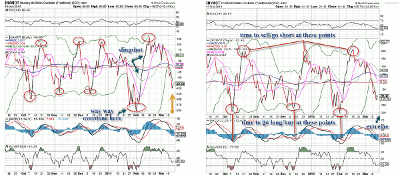Veteran options trader Bob Lang of ExplosiveOptions.net shares how he uses one of his favorite indicators to identify short-term changes in trends, which helps him identify entry and exit points.
Being a contrarian at heart, it’s not easy for me to play the options game. I have a really tough time playing for reversals, as trying to game tops or bottoms is a loser’s game. I prefer to confirm a reversal, jump in to take advantage of the “meat” of the move, and escape when I’m satisfied with a gain (or see that the chart is giving me a signal to get out), all before anyone sees me.
But how do we play an oversold market within a longer-term uptrend—like today’s market? I won’t event attempt to call the turn, and I’ll probably be late to get on board, but that’s fine by me. If you’ve been in the game during the past year, you know that the operative action has been to buy the dip, an opportunity that never lasts long. Until that pattern changes, I will continue to play the markets this way.
Let’s talk about short-term trends instead. There are several different sentiment indicators that do a pretty good job of predicting short-term trend changes. These include the VIX, put/call ratio, Rydex ratio, sentiment polls, support/resistance levels (magnets), bullish/bearish percent and the McClellan Oscillator. They are all reliable, but given the speed at which this market has been turning, the two best indicators for me have been the VIX and the McClellan oscillator.
Today, we’ll focus on the McClellan, which has accurately called very extreme market conditions and their quick turns. As an options trader, following these signals is crucial to finding entry levels for both bullish and bearish plays. The McClellan not only tells us the condition of the market, but it has been used as a great predictor of short-term changes in trend as well.
The oscillator is a smoothed-out moving average of the advance/decline line. Simply put, a negative reading shows money flowing out, while a positive reading shows money flowing in. Extreme readings indicate points of exhaustion; we can expect some pretty severe moves in the opposite direction to occur imminently. When readings are +100 to -100, I score these as overbought; higher or lower numbers are too extreme for the market, so a reversal in the trend (or overshooting the move) can be expected. While this is a raw and crude way to interpret the conditions, adding up the values for a given time period may be a more useful indicator, which is exactly what the Summation Index does.
Take a look at the charts below for the NYSE McClellan Oscillator and the Nasdaq McClellan Oscillator, which I use regularly to see where we are and where we might be going. You can see from the circled areas on the chart that there were a few ideal points to go bullish or bearish.
The deep oversold readings (big minus numbers) were areas to go long, while big positive numbers were areas to sell or short. All were ideal places to get in and go against the grain. I will often look for these conditions and place a contrarian bet, knowing the market is due for a change. Currently, we’re oversold, but not to the extent where a slingshot-type move is imminent. That could be coming soon, though!
By Bob Lang of ExplosiveOptions.net






















